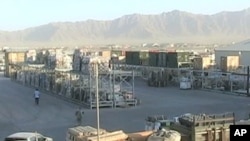U.S. President Barack Obama announced a new strategy for Afghanistan Tuesday that includes sending at least 30,000 more American troops to the war front. The increase will bring the number of U.S. troops in Afghanistan to about 100,000. But the infrastructure to support U.S. military efforts in Afghanistan is already strained, posing challenges to a troop surge.
Somewhere over southern Afghanistan, a U.S. Air Force transport crew prepares to drop a load of supplies by parachute to a Marine unit below.
Rugged terrain, poor roads and relentless enemy attacks force U.S. planners to deliver most combat supplies by air. "You just don't have the lines of communication, the road structure, that brings things here sufficiently," said U.S. Air Force Brig. Gen. Steve Kwast.
How to get supplies to troops is just one of several logistical problems that U.S. planners need to address if thousands of new American troops join the eight-year-long war in Afghanistan. The Pentagon budgeted $1.4 billion for new construction in Afghanistan for 2010. But much more may be needed.
The logistical challenges intersect at Bagram Airfield, outside Kabul. A former Soviet base, Bagram is the main supply, personnel and medical hub for the war effort. "The facility here is the central hub for the development of governance and security in Afghanistan. What I mean by that is, everything that comes into Afghanistan comes in through air, if it has any short-term requirement," said Kwast, who oversees air operations at the base.
The passenger terminals and cargo yards are filled to capacity, "Each day we move approximately 4,000 passengers a day, inbound and outbound, plus 400 tons of cargo per day," said Lt. Col. Dan Krall, a logistician working under Kwast.
Medical infrastructure represents another problem. With mounting casualties, Bagram's military hospital, the biggest in Afghanistan, is working overtime. Hospital commander Col. Joe Chozinski says emergency cases are up five times compared to last year. "In any given month we see 3 to 4,000 people. To compare us to something in the United States. If you look at the number of patients, the number of surgeries and how critical they are, we're equivalent to about the busiest trauma center in the entire United States," he said.
To meet demand, the Bagram hospital has added a large tent to house patients awaiting flights to U.S. facilities. Additional troops will need even more facilities. And the cargo to feed and supply those troops will require more flights and more storage facilities. It's a fact not lost on U.S. Central Command. "They're aware of our backlog," Krall said.
News
Logistics Play Key Role in US War Effort in Afghanistan
update
- By Suu Mon Aye

Infrastructure to support U.S. military efforts in Afghanistan is already strained, posing challenges to the troop surge announced by President Obama






